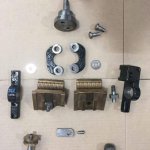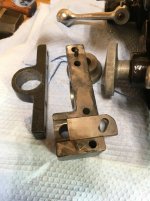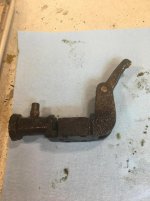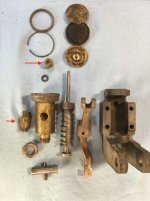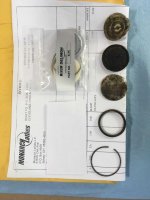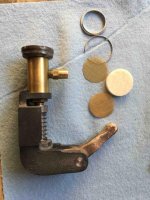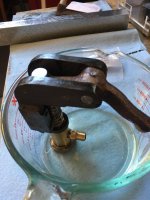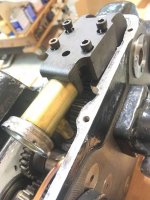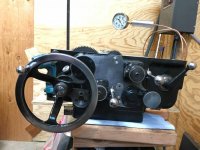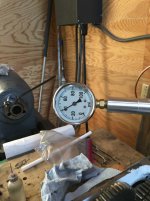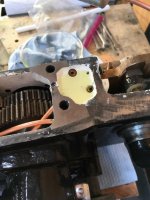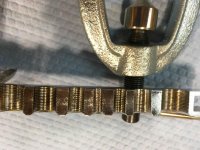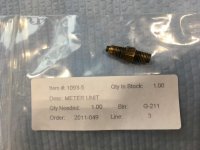kmsorensen
Plastic
- Joined
- Oct 24, 2017
The reason the plumbing needed doing is that it has to be routed before the Half Nuts go in, which is now going to happen.
The first image is annotated, referring back to the first posting and to the Round Dial Manual. I’m doing this because there are several ways to go wrong here. Also some of the most important parts are not in this image. Not in the image are two setscrews and a taper pin.
The taper pin mates the Half Nut Lever (91) to the Half Nut Cam (93) between the Half Nut Washer (92) and the casting. The fact that it is a taper pin means that while it looks like you can put the Half Nut Cam (93) into the casting either of two ways, you can’t. There is a right way and a way that will result in your disassembling all the half nut parts later when you realize that the Half Nut Lever and the Cross Feed Lever aren’t getting along.
The setscrews secure the two Half Nut Cam Pins (94) to the Half Nut Cam (93). When you’re taking this apart you remove these two setscrews, and then drive the Half Nut Cam Pins out the back of the Half Nut Cam using a pin punch through the two small holes in the forward facing face of the Half Nut Cam. When you’re putting it together, you put the Half Nut Cam Pins (94) through the bushings (98) in the Half Nut Arms (97), carefully lining up the holes for the 8-32 set screws which you then place securing the Half Nut Arms and Half Nut Pins to the Half Nut Cam. Easy Peasy yes? Actually maybe not. There are several ways the Half Nut Arms (97) can go on the Half Nut Cam, and as usual only one of these ways works. The Half Nut Arms are not symmetrical front to back, and the casting is not symmetrical left to right, nor up and down. Including the taper pin through the Half Nut Lever, that makes eight ways to put this assembly together and have it look OK to the casual observer. Only one of these ways will make you anything like happy. If the Half nut Lever faces away from all the other levers on the apron front, and you can cycle the Half Nut Cam with the Half Nut Arms attached, moving like you want them to, and not having the casting interfere with their movement, you’re there. It’s not difficult if you spend a little time looking things over. The final time I assembled these parts I greased the casting / Half Nut Cam interface and the bushings in the Half Nut Arms prior to assembly. If you’re taking it apart, don’t forget the setscrews.
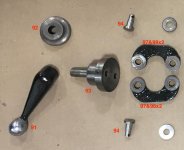
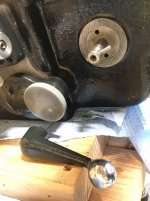

The first image is annotated, referring back to the first posting and to the Round Dial Manual. I’m doing this because there are several ways to go wrong here. Also some of the most important parts are not in this image. Not in the image are two setscrews and a taper pin.
The taper pin mates the Half Nut Lever (91) to the Half Nut Cam (93) between the Half Nut Washer (92) and the casting. The fact that it is a taper pin means that while it looks like you can put the Half Nut Cam (93) into the casting either of two ways, you can’t. There is a right way and a way that will result in your disassembling all the half nut parts later when you realize that the Half Nut Lever and the Cross Feed Lever aren’t getting along.
The setscrews secure the two Half Nut Cam Pins (94) to the Half Nut Cam (93). When you’re taking this apart you remove these two setscrews, and then drive the Half Nut Cam Pins out the back of the Half Nut Cam using a pin punch through the two small holes in the forward facing face of the Half Nut Cam. When you’re putting it together, you put the Half Nut Cam Pins (94) through the bushings (98) in the Half Nut Arms (97), carefully lining up the holes for the 8-32 set screws which you then place securing the Half Nut Arms and Half Nut Pins to the Half Nut Cam. Easy Peasy yes? Actually maybe not. There are several ways the Half Nut Arms (97) can go on the Half Nut Cam, and as usual only one of these ways works. The Half Nut Arms are not symmetrical front to back, and the casting is not symmetrical left to right, nor up and down. Including the taper pin through the Half Nut Lever, that makes eight ways to put this assembly together and have it look OK to the casual observer. Only one of these ways will make you anything like happy. If the Half nut Lever faces away from all the other levers on the apron front, and you can cycle the Half Nut Cam with the Half Nut Arms attached, moving like you want them to, and not having the casting interfere with their movement, you’re there. It’s not difficult if you spend a little time looking things over. The final time I assembled these parts I greased the casting / Half Nut Cam interface and the bushings in the Half Nut Arms prior to assembly. If you’re taking it apart, don’t forget the setscrews.





